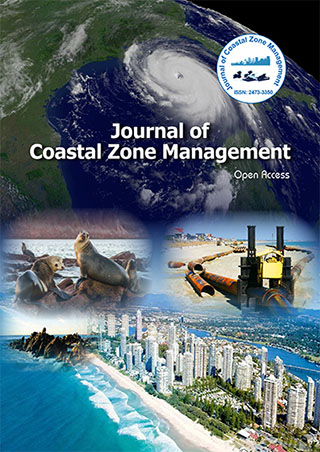Indexed In
- SafetyLit
- RefSeek
- Hamdard University
- EBSCO A-Z
- OCLC- WorldCat
- Publons
Useful Links
Share This Page
Journal Flyer

Open Access Journals
- Agri and Aquaculture
- Biochemistry
- Bioinformatics & Systems Biology
- Business & Management
- Chemistry
- Clinical Sciences
- Engineering
- Food & Nutrition
- General Science
- Genetics & Molecular Biology
- Immunology & Microbiology
- Medical Sciences
- Neuroscience & Psychology
- Nursing & Health Care
- Pharmaceutical Sciences
Perspective - (2024) Volume 27, Issue 6
Coastal Biodiversity and Climate Change: Effects and Resistance Procedures
Ceaser Seipt*Received: 28-Oct-2024, Manuscript No. JCZM-24-27583; Editor assigned: 30-Oct-2024, Pre QC No. JCZM-24-27583 (PQ); Reviewed: 15-Nov-2024, QC No. JCZM-24-27583; Revised: 22-Nov-2024, Manuscript No. JCZM-24-27583 (R); Published: 29-Nov-2024, DOI: 10.35248/2473-3350.24.27.655
Description
Climate change poses a significant threat to coastal biodiversity, impacting ecosystems and species that depend on these environments for survival. Rising sea levels, increased temperatures, ocean acidification and changing weather patterns are just a few of climate change disrupts coastal ecosystems. This article describes the impacts of climate change on coastal biodiversity and discusses adaptation strategies to protect these major ecosystems.
Coastal ecosystems, including mangroves, salt marshes, seagrasses and coral reefs, are particularly vulnerable to climate change due to their proximity to the ocean. Rising sea levels, driven by melting polar ice and thermal expansion of seawater, can inundate coastal habitats, reducing the available land for flora and fauna. This can lead to habitat loss and displacement of species that rely on these ecosystems.
In addition to rising sea levels, increased ocean temperatures can stress marine organisms, particularly coral reefs. Coral bleaching occurs when corals expel the symbiotic algae (zooxanthellae) that provide them with nutrients and color, resulting in white, unhealthy corals. If temperatures remain elevated, this can lead to widespread coral mortality, affecting the entire marine food web and the countless species that depend on coral reefs for shelter and sustenance.
Ocean acidification, caused by the absorption of excess atmospheric CO2, poses another significant threat to coastal biodiversity. Increased acidity can hinder the ability of marine organisms, such as shellfish and corals, to build their calcium carbonate shells and skeletons. This not only affects individual species but can disrupt entire ecosystems, leading to declines in biodiversity.
To mitigate the impacts of climate change on coastal biodiversity, a range of adaptation strategies can be used. One effective approach is the establishment of Marine Protected Areas (MPAs), which help safeguard critical habitats from human activities such as overfishing, pollution and coastal development. MPAs can enhance the resilience of marine ecosystems by allowing natural processes to occur without interference.
Restoration efforts are also protecting coastal biodiversity. Initiatives to restore mangroves, salt marshes and seagrasses can help improve habitat quality and enhance ecosystem services. These habitats provide essential nurseries for juvenile fish, protect coastlines from erosion and store carbon, contributing to climate change mitigation.
Another adaptation strategy involves promoting the sustainable management of coastal resources. Implementing practices that reduce pollution, control invasive species and ensure the sustainable harvesting of marine resources can help maintain the health of coastal ecosystems. By addressing the pressures on biodiversity, these strategies enhance resilience to climate change.
Participatory approaches that involve local interesting groups in decision-making processes can lead to more effective and sustainable outcomes. By incorporating traditional knowledge and local experiences, adaptation strategies can be customized to the specific needs and conditions of coastal communities.
Climate change poses a Challenging threat to coastal biodiversity, impacting ecosystems and the species that inhabit them. However, by implementing effective adaptation strategies, such as establishing MAPs, restoring critical habitats and promoting sustainable resource management, it is possible to protect these major ecosystems. Engaging local communities in conservation efforts and raising awareness about the importance of coastal biodiversity is essential for fostering resilience in the face of climate change. As we confront the challenges posed by a changing climate, safeguarding coastal biodiversity must remain a priority for the health of both ecosystems and human communities.
Citation: Seipt C (2024). Coastal Biodiversity and Climate Change: Effects and Resistance Procedures. J Coast Zone Manag. 27:655.
Copyright: © 2024 Seipt C. This is an open-access article distributed under the terms of the Creative Commons Attribution License, which permits unrestricted use, distribution, and reproduction in any medium, provided the original author and source are credited.
